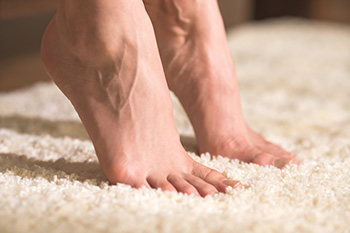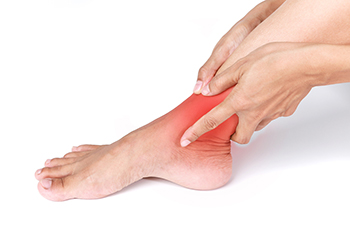Items filtered by date: October 2022
Effective Foot Stretches and How to Perform Them

There are many benefits to frequently performing foot exercises. Stretching and exercising the feet make them stronger, and this can be helpful in possibly preventing falls, in addition to reducing existing foot and ankle pain. The range of motion is often improved, and slow stretching can improve flexibility. When the toes are raised, pointed, and curled, it may help to strengthen the Achilles tendon, which is connected to the heel. This can be done by sitting in a chair, and alternating pointing, raising, and curling the toes. Each position can be held for a few seconds, then repeated approximately 10 times. An effective stretch for the toes is called the toe splay and is also done while sitting in a chair. The heels can be firmly resting on the ground, and the toes are stretched out and moved several times. The entire foot can be strengthened when toe extensions are performed. While one leg is crossed over the other, take one hand and manually move the toes back until a gentle stretch is felt. If you would like more information about the benefits of exercising the feet, please speak with a podiatrist who can recommend specific stretches for you.
Exercising your feet regularly with the proper foot wear is a great way to prevent injuries and build strength. If you have any concerns about your feet, contact Deborah Rosenfeld from Rosenfeld Podiatry. Our doctor can provide the care you need to keep you pain-free and on your feet.
Exercise for Your Feet
Exercise for your feet can help you gain strength, mobility and flexibility in your feet. They say that strengthening your feet can be just as rewarding as strengthening another part of the body. Your feet are very important, and we often forget about them in our daily tasks. But it is because of our feet that are we able to get going and do what we need to. For those of us fortunate enough to not have any foot problems, it is an important gesture to take care of them to ensure good health in the long run.
Some foot health exercises can include ankle pumps, tip-toeing, toe rises, lifting off the floor doing reps and sets, and flexing the toes. It is best to speak with Our doctor to determine an appropriate regimen for your needs. Everyone’s needs and bodies are different, and the activities required to maintain strength in the feet vary from individual to individual.
Once you get into a routine of doing regular exercise, you may notice a difference in your feet and how strong they may become.
If you have any questions please feel free to contact our office located in Marlton, NJ . We offer the newest diagnostic and treatment technologies for all your foot and ankle needs.
Hammertoe Is a Deformity

The toes provide harmony to the body, and the foot condition that is referred to as hammertoe may cause difficulty in walking and can affect balance. Hammertoe is caused by an imbalance in the foot and can occur from wearing shoes that do have adequate room for the toes to move freely in. It affects the second and third toes, causing them to bend down at the joint, resembling a hammer. It is suggested that medical attention is sought when the first symptoms of hammertoe appear, and the toes may be straightened easily. In severe cases, larger shoes may have to be purchased, in addition to possibly having surgery performed for permanent straightening. Recovery time from this type of surgery may take several weeks, and it is advised that you seek the counsel of a podiatrist in the early stages who can offer correct treatment methods.
Hammertoes can be a painful condition to live with. For more information, contact Deborah Rosenfeld of Rosenfeld Podiatry. Our doctor will answer any of your foot- and ankle-related questions.
Hammertoe
Hammertoe is a foot deformity that occurs due to an imbalance in the muscles, tendons, or ligaments that normally hold the toe straight. It can be caused by the type of shoes you wear, your foot structure, trauma, and certain disease processes.
Symptoms
- Painful and/or difficult toe movement
- Swelling
- Joint stiffness
- Calluses/Corns
- Physical deformity
Risk Factors
- Age – The risk of hammertoe increases with age
- Sex – Women are more likely to have hammertoe compared to men
- Toe Length – You are more likely to develop hammertoe if your second toe is longer than your big toe
- Certain Diseases – Arthritis and diabetes may make you more likely to develop hammertoe
Treatment
If you have hammertoe, you should change into a more comfortable shoe that provides enough room for your toes. Exercises such as picking up marbles may strengthen and stretch your toe muscles. Nevertheless, it is important to seek assistance from a podiatrist in order to determine the severity of your hammertoe and see which treatment option will work best for you.
If you have any questions, please feel free to contact our office located in Marlton, NJ . We offer the newest diagnostic and treatment technologies for all your foot care needs.
Ankle Stretches

Many different individuals might experience some kind of ankle pain or stiffness at some point in their lives. There are many different causes and types of ankle pain. However, if the ankle is feeling stiff, sore, or painful, gently stretching the ankle may be beneficial for some people. An individual might consider performing ankle circles where, in a seated position with one leg crossed over another, you move the foot off of the ground in a circle. Another potential stretch is known as the towel stretch where a person sits on the ground with their legs stretched out in front of them. Then, the person wraps a towel around the bottom of the feet, and gently and repeatedly pulls the towel toward themselves. Of course, it is always a good idea to consult with a medical professional before performing stretches. Contact a podiatrist today to see if you can mitigate your ankle pain or stiffness by performing any of these stretches.
Ankle pain can be caused by a number of problems and may be potentially serious. If you have ankle pain, consult with Deborah Rosenfeld from Rosenfeld Podiatry. Our doctor will assess your condition and provide you with quality foot and ankle treatment.
Ankle pain is any condition that causes pain in the ankle. Due to the fact that the ankle consists of tendons, muscles, bones, and ligaments, ankle pain can come from a number of different conditions.
Causes
The most common causes of ankle pain include:
- Types of arthritis (rheumatoid, osteoarthritis, and gout)
- Ankle sprains
- Broken ankles
- Achilles tendinitis
- Achilles tendon rupture
- Stress fractures
- Bursitis
- Tarsal tunnel syndrome
- Plantar fasciitis
Symptoms
Symptoms of ankle injury vary based upon the condition. Pain may include general pain and discomfort, swelling, aching, redness, bruising, burning or stabbing sensations, and/or loss of sensation.
Diagnosis
Due to the wide variety of potential causes of ankle pain, podiatrists will utilize a number of different methods to properly diagnose ankle pain. This can include asking for personal and family medical histories and of any recent injuries. Further diagnosis may include sensation tests, a physical examination, and potentially x-rays or other imaging tests.
Treatment
Just as the range of causes varies widely, so do treatments. Some more common treatments are rest, ice packs, keeping pressure off the foot, orthotics and braces, medication for inflammation and pain, and surgery.
If you have any questions, please feel free to contact our office located in Marlton, NJ . We offer the newest diagnostic and treatment technologies for all your foot care needs.
Wounds That Don't Heal Need to Be Checked
Puncture Wounds

When an individual steps on a small, pointy object, they may endure what is known as a puncture wound of the foot. Puncture wounds create small holes in the skin, and can be caused from stepping on nails, seashells, or pieces of glass, among other things. Injuring the foot in this way is more common during the warmer months because individuals are more likely to walk around barefoot. Puncture wounds can be problematic because the foreign object may become embedded in the skin if not properly treated. Additionally, the wound may facilitate an infection because dirt and debris can become stuck in the entry hole from the wound. In treating a puncture wound, a medical professional will ensure that the foreign body has been removed from the affected area and that the wound is properly cleaned. It is also important to remember that the depth of the puncture can indicate the likelihood of developing an infection, as deeper punctures can be more problematic. Contact a podiatrist today if you believe you have a puncture wound.
Wound care is an important part in dealing with diabetes. If you have diabetes and a foot wound or would like more information about wound care for diabetics, consult with Deborah Rosenfeld from Rosenfeld Podiatry. Our doctor will assess your condition and provide you with quality foot and ankle treatment.
What Is Wound Care?
Wound care is the practice of taking proper care of a wound. This can range from the smallest to the largest of wounds. While everyone can benefit from proper wound care, it is much more important for diabetics. Diabetics often suffer from poor blood circulation which causes wounds to heal much slower than they would in a non-diabetic.
What Is the Importance of Wound Care?
While it may not seem apparent with small ulcers on the foot, for diabetics, any size ulcer can become infected. Diabetics often also suffer from neuropathy, or nerve loss. This means they might not even feel when they have an ulcer on their foot. If the wound becomes severely infected, amputation may be necessary. Therefore, it is of the upmost importance to properly care for any and all foot wounds.
How to Care for Wounds
The best way to care for foot wounds is to prevent them. For diabetics, this means daily inspections of the feet for any signs of abnormalities or ulcers. It is also recommended to see a podiatrist several times a year for a foot inspection. If you do have an ulcer, run the wound under water to clear dirt from the wound; then apply antibiotic ointment to the wound and cover with a bandage. Bandages should be changed daily and keeping pressure off the wound is smart. It is advised to see a podiatrist, who can keep an eye on it.
If you have any questions, please feel free to contact our office located in Marlton, NJ . We offer the newest diagnostic and treatment technologies for all your foot care needs.


